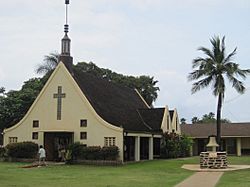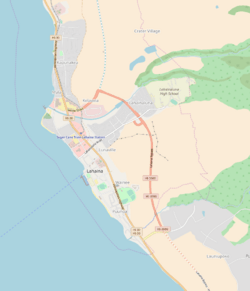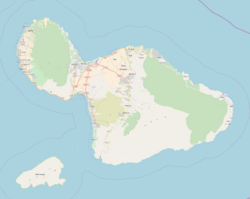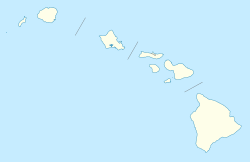Waiola Church facts for kids
Quick facts for kids |
|
|
Waiola Church and Cemetery
|
|
|
U.S. Historic district
Contributing property |
|

Waiola Church in 2010
|
|
| Location | 535 Waineʻe street Lahaina, Hawaii |
|---|---|
| Area | 2.54 acres (1.03 ha) |
| Built | 1832, rebuilt 1954 |
| Demolished | 1894, 2023 |
| Part of | Lahaina Historic District (ID66000302) |
The Waiola Church and Cemetery is a very old and important place in Lāhainā, on the island of Maui in Hawaiʻi. It started as a Christian mission way back in 1823.
The church was first known as Waineʻe Church until 1953. The cemetery next to it is where many important people are buried. This includes early members of the royal family from the Kingdom of Hawaii.
Sadly, the church building was destroyed by fire in 1894. It was rebuilt, but then it was lost again in the big 2023 Hawaii wildfires in 2023.
Contents
History of Waiola Church
The first Christian mission on Maui began in 1823. It was started by a missionary named Reverend William Richards.
At first, the church used simple buildings made of wood and grass. In 1828, the island's Governor, Hoapili, helped build a stronger church. It was made of stone and wood.
This new Christian church was built next to a pond. This pond surrounded an island called Mokuʻula. Mokuʻula was a very special and sacred place for the traditional Hawaiian religion. It was also where the king lived.
The first stone church building was officially opened on March 4, 1832. It was named Waineʻe Church.
Reverend Dwight Baldwin came to the church in 1836. He was a doctor as well as a religious leader. He helped the community a lot.
Lahaina was the capital of the Hawaiian Kingdom from the 1820s to the mid-1840s. During this time, Waineʻe Church was the church for the Hawaiian royal family.
Many members of the royal family were later buried in the church's cemetery in 1884. This cemetery was the first Christian cemetery in all of Hawaiʻi. It's special because missionaries and Native Hawaiians were buried there side by side.
Another important building, called Hale Halewai (which means "meeting house"), was built nearby. In 1855, the church members built an even bigger building. They called it Aloha Hale (meaning "aloha house"). It was finished in 1858. This building was a way to celebrate how Dr. Baldwin helped save the people of Maui from a serious smallpox sickness in 1853.
Later, in 1859, the government added benches and desks to Aloha Hale. They used it as a school.
In 1894, a fire destroyed the Waineʻe Church. A new church was built with money donated by Henry Perrine Baldwin. He was the son of the original pastor, Dwight Baldwin.
In the 1950s, a strong wind storm damaged the church. A new, modern church building was finished in 1953. At this time, its name was changed to Waiola, which means "living water." The bell from the old Aloha Hale tower was saved and used in the new Waiola Church.
Hale Aloha was fixed up in 1908. But over time, it became old and damaged. In 1973, work began to restore it. It was fully rebuilt by 1985. A bell tower that was built in 1910 was also restored. A new bell was put in the Hale Aloha tower in 2009.
In August 2023, the Waiola Church building was sadly destroyed again by the 2023 Hawaii wildfires.
About the Church
Waiola Church and Hale Aloha are both important parts of the Lahaina Historic District. This district was named a special "National Historic Landmark District" in 1962.
The church is led by Pastor Kahu Anela Rosa. Sunday services are held at 9:00 a.m. The services mix Hawaiian and English languages and songs. The church is part of the Hawaii Conference of the United Church of Christ.
Important Burials in the Cemetery
Many important people are buried in the cemetery. Here are some of them and their death dates:
- Queen Keōpūolani, September 16, 1823
- King Kaumualiʻi, May 26, 1824
- Princess Nāhiʻenaʻena, December 30, 1836
- Queen Kuini Liliha, August 25, 1839
- Ulumāheihei Hoapili, also known as Hoapili, January 3, 1840
- Kalākua Kaheiheimālie, also known as Hoapili Wahine, January 16, 1842
- Princess Kekauʻōnohi, granddaughter of Kamehameha I, June 2, 1847
- Reverend William Richards, November 7, 1847
Images for kids
-
Tombstone for Keōpūolani, Nahienaena, Liliha, Ulumaheihei, Kalākua Kaheiheimālie, Kekauonohinui










